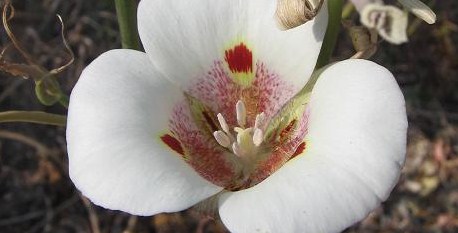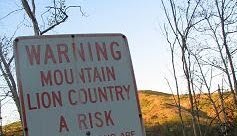
This is a picture of me & my new "barefoot" shoes I wear to work. But first, a story (I got out for a trail run yesterday: trailhead, Santiago Oaks Regional Park\)
Mountain biker getting his breath at the top of Mountain Goat Trail: “No shoes?”
My reply (over my shoulder, as I left him in a very tiny cloud of barefooting dust): “Not today.”
Although he had started up the trail with a 20-yard lead, I caught him right at the top. Was this because I took the “shortcut” route? I still love that old path, the pre- “let's get a bulldozer up here and make a freeway up to Barham Ridge” trail. It's got one awesomely steep sandstone section where I have to use my hands to crawl up the almost-vertical eroded yellow rock.
Rock crawling = fun.
Especially when you're 50 and can't run so fast any more. So the rock-scrambling turtle caught the two-wheeled hare. And, weirdly enough, I was hardly breathing, while the biker guy (OK, he was probably 10 years older than me) was panting quite a bit.
My ongoing barefooting research has turned up the interesting factoid that shoelessness means about 5% less effort (the weight of the shoes, etc.). Is that why it's been so difficult to get my heart rate up since I began leaving my running shoes at home? Or just the fact that it's hard to get any kind of speed up when the trail is full of )$(@*! chunks of rock just waiting for me not to see them . . .
But really, that's actually why I like the whole idea of going barefoot on the trail—with speed out of the equation, what makes my runs challenging is having to pay attention to the trail surface so as not to overdose on arch bruises. Ouch. Even a smallish rock, if it's sharp enough and I land wrongly, brings me back out of any daydreaming and back to Painville.
I don't live there long, though. Next door to Painville is Flowerhaven, and as I scan uptrail and around I note some of my new neighbors in the Barham Ranch subdivision (inventory as of yesterday): wild hyacinth, three kinds of lupine, Catalina mariposa lily, purple nightshade, popcorn flower, bush sunflower, and more whose names and faces I'm forgetting.
Kinds of “barefoot sensation” shoes I researched recently: Feelmax, Vivos, Skora, Tod's, Softstar, Vibram Five Fingers.
What I ended up with to wear to work: Soft Star Grippy Roos in chocolate suede ($63 + shipping, with the added plus that the Oregon Elves who made them included a little handwritten thank-you note). www.softstarshoes.com
I wear these with any outfits that don't involve black pants...the brown suede is just too noticeable then. I hope to invest in a pair of Softstar Ramblers in smooth black leather...my next discretionary $75.
I tried to just listen as fellow hiking and biking volunteers discussed the Vibram Five Fingers shoe during breaktime at our recent CPR/First Aid class. What I wanted to say: try NOTHING. Just your bare feet and the trail. But I didn't.
However, to the new docent (who told me about how he needed different boots, as his feet were bloody after a recent hike to the weather station on the Fremont dirt road) I did offer some advice: “Just wear those running shoes you've got on right now. Unless you're carrying a 40-pound pack, you don't need hiking boots.” Less shoe = more comfort. Now I've taken that to the (il)logical conclusion: NO shoes = total and complete awesomenemnity on the trail.
What made the 9-5 of CPR and First Aid training day (including the module “When Help is Delayed”) completely worth it? (Besides of course Louie-the-trainer's funny and useful presentation about all things lifesaving. . . )
. . . The young lady sitting next to me for the afternoon session had a story (these classes are often de-railed by story, but not so much of that yesterday) about being bit by by a rattlesnake while hiking alone.
This scenario, more than being devoured scalp-to-toenails by a mountain lion, is probably my biggest concern.
There are lots of rattlers in our wild hills, and I can't count the times I've surprised one lying on or next to the trail. (Or do they surprise me . . . it might be a toss-up . . . )
Anyway, she said she spent 10 minutes trying to work the suction device she'd packed for just such an occasion. (The device is called a Sawyer Extractor.) She finally gave up on that and slowly hiked the mile back to her car at the trailhead, then drove herself to the emergency room, where they told her she had wasted her time with the attempt at venom extraction. What they really wanted to know, at the emergency room, was what kind of snake it was. She did not have a positive ID, but since there were only two venomous snakes native to the area (I forget where she was...somewhere in the dry Southwest), the ER docs were able to adminster the appropriate anti-venin.
She said the bite area on her leg was painful for weeks, but she recovered completely.
Then Louie-the-CPR-instructor had a similar story: he knew of another solitary woman runner who had been bit in the OC backcountry—she panicked, and sprinted back to the trailhead. Yikes. He couldn't remember if she died, but from what he could re-call she at least was in serious condition for a while.
What I learn from this: stay calm. ID the snake. Get back to the car slowly.
It all reminded me very much of the article in Backpacker magazine a couple of years ago . . . I looked up the link . . . if you want to read about the #1 killer in the backcountry, here's the info:
(Spoiler alert: it's NOT hypothermia, but you'll have to read the article to find out why one young hiker "mercy-killed" his companion only a mile from the trailhead . . . )
http://www.backpacker.com/gear/11044?page=7
After the CPR class there was still time for a run . . . that's when I hit the Mountain Goat trail on the mountain-biker-chasing-adventure mentioned previously.
I saw two of the first snake tracks of the season crossing the trail. It's time to be on the lookout.
Not freakout.
Happy Spring Equinox!



No comments:
Post a Comment